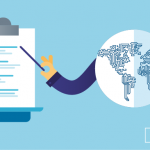
Data classification and Data Loss Prevention (DLP) solutions are essential tools for effective data management strategies and data breach prevention. They have become key to complying with laws and international standards such as the GDPR, HIPAA, and PCI DSS. Let’s take a closer look at data classification, what it is, and how a DLP solution can help.
What is Data Classification?
Data classification is the process of organizing data into appropriate categories for more efficient use and protection of data across company networks.
In the context of information security, data is tagged based on its level of sensitivity, making it easier to find, track, and safeguard. Organizations can automate data categorization or do it manually, with advanced data classification solutions using machine learning for better accuracy.
Major categories of sensitive data
While data classification categories can vary depending on the companies, there are four major categories of sensitive data:
- Highly sensitive data – Information that, if made public, puts the company in danger of legal action, regulatory noncompliance, or financial loss. This includes critical data crucial to the organization, especially personally identifiable information (PII), intellectual property (IP), and other industry-specific categories of sensitive data.
- Internal sensitive data – Information that, if revealed, can pose a risk to company operations. These include sales data, customer information, employee salaries, etc.
- Internal data – Information that, while not sensitive, is not publicly available, such as organizational charts, marketing strategies, etc.
- Publicly available data – Information that everyone within and outside the organization has access to, for example, product descriptions, company addresses, etc.
While it would be ideal to categorize all data, few companies can afford to given the enormous amounts of data organizations now process. Tagging every data item is a cumbersome, time-consuming, and, ultimately, expensive endeavor.
Companies must build their own data classification categories that include both sensitive data – as defined by various regulations that they need to comply with – and what’s considered industry-specific sensitive information.
Making sensitive data easily identifiable is essential under regulations such as GDPR that require companies not only to be able to find such data and protect it but also to demonstrate their ability to do so. It is also essential for organizations to comply with users’ requests to access or erase their personal data within a given time frame. Failure to do so can result in heavy fines and a loss of customer trust.
Benefits of Data Classification
Data classification serves as the cornerstone of a robust data security strategy. Data classification tools significantly contribute to risk management, regulatory compliance, and data security. Some of the key benefits of data classification in DLP include:
- Improved data security – Data classification enables organizations to identify and prioritize their most critical data assets. By implementing appropriate security controls and measures based on the classification, organizations can significantly reduce the risk of data breaches and unauthorized access.
- Regulatory compliance – Many industries have specific data protection requirements and regulations. Data classification helps organizations identify the data that falls under these regulations and ensures compliance with legal obligations.
- Efficient incident response – In the event of a data breach or security incident, data classification allows organizations to quickly identify the affected data and take appropriate remedial actions. This helps minimize the impact and potential damage caused by such incidents.
By leveraging the benefits of data classification in DLP, organizations can enhance their overall cybersecurity posture and protect their sensitive information from unauthorized access, loss, or exposure.
Data Classification Best Practices
There are various best practices that organizations can follow to effectively classify their data. Some include clearly defined classification criteria, regular training and awareness programs, and continuous monitoring and review.
By establishing a clear and consistent criterion for classifying data, organizations can ensure that all stakeholders have a common understanding of the classification process. Employees should be regularly trained on data classification policies, procedures, and best practices. This helps create a culture of data protection and ensures that everyone understands their roles and responsibilities. Data classification should be an ongoing process, and organizations should regularly monitor the effectiveness of their classification framework and make necessary adjustments based on changes in data security requirements.
By adopting these best practices, organizations can enhance the accuracy and effectiveness of their data classification efforts.
How Data Classification Works with Endpoint Protector
Content Aware Protection (CAP) from Endpoint Protector by CoSoSys works well with data classification solutions to provide companies with the best protection against insider threats and data leaks.
While creating CAP policies, companies can build their custom dictionaries using their data classification tags. In this way, Endpoint Protector’s content scanner easily picks up metadata of the tags added through automated classification processes. Different remediation actions can then be applied depending on the type of data tag. For example, DLP policies can be created that block the transfer of data tagged as highly sensitive or that only report the transfer of internal data.
Endpoint Protector currently extracts classification metadata from numerous file types, and new ones are added all the time.
Data classification represents an added layer of data security when used in conjunction with DLP security solutions. It makes highly sensitive information instantly recognizable to DLP tools scanning data classification tags, ensuring that the right policies are applied to restrict or block their transfer.
Frequently Asked Questions
- Content-based classification: identifies sensitive information by inspecting and interpreting files and documents;
- Context-based classification: looks at indirect indicators of sensitive information such as the application that created the file, the person who created the document, or the location in which files were authored or modified;
- User-based classification: relies on user knowledge and involves a manual, end-user selection of each file (when the document is created, after a significant edit, or before the document is released).
Data protection regulations such as the GDPR or PCI DSS require organizations to protect particular data, such as EU residents’ personal data or cardholder information. Data classification enables companies to identify sensitive data subject to specific regulations; thus they can apply the required controls and pass audits.
By deploying a Data Loss Prevention (DLP) solution, organizations can reach easier the compliance requirements of different data protection regulations such as the GDPR, HIPAA, CCPA, PCI DSS, SOX, etc. DLP tools can find, monitor, and control sensitive information, as well as help to ensure that employees cannot transfer, copy, or upload data classified as personal information under data protection laws. With a DLP solution, companies can set sensitive data policies, scan all data transfers, report or block unauthorized data transfers, generate detailed reports, etc.
Data discovery implies identifying sensitive data such as Personally Identifiable Information (PII) and Intellectual Property (IP) for adequate protection or safe removal. It is an essential step to ensure compliance with different data protection regulations. Data discovery enables organizations to assess the complete data picture and implement security measures to prevent the loss of sensitive data.
Download our free ebook on
Data Loss Prevention Best Practices
Helping IT Managers, IT Administrators and data security staff understand the concept and purpose of DLP and how to easily implement it.
















